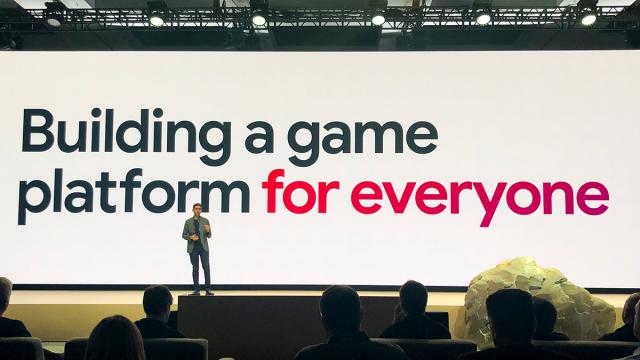Google is taking on the big guys. In a keynote at Game Developers Conference in San Francisco today Google announced a new service, Stadia, that will allow gamers to play the biggest games on any Android or Chrome-based device (including any device with a Chrome browser).
It could be extraordinary. I mean… the name isn’t. The name is absolutely terrible and sounds like a disease. But the service itself could be extraordinary.
Google isn’t the first to attempt game streaming—Nvidia has been doing it via its GeForce Now service since 2015, while European startup Shadow launched its game streaming service in the U.S. in 2018. Meanwhile one of Google’s most obvious rivals, Microsoft, is planning to launch its own game streaming service later this year.
Google’s Stadia service works on any device that supports the Chromecast protocol, which means iOS, Android, Chrome OS, macOS, Windows, and even the Chromecast dongle. They all speak to one of Google’s 7,500 data center nodes (which span the globe) and recognise your specific account, allowing you to move from one device to the other without a bunch of messy handoffs between systems, because the actual game is running at the data center.
In the controlled on-stage demo, the handoff from one system to the next was seamless—a far cry from my experience with Shadow, which can do the same thing with a measure of lag when switching devices.
Stadia will support up to 4K resolution at 60 frames per second, with HDR and surround sound, and a second stream, for YouTube streaming purposes, at 4K and 60fps. Google also promises 8K and 120fps in a future update.
The service isn’t just a Windows 10 instance running on a server somewhere. Instead, Stadia is an entirely new platform based on Linux and running on custom AMD hardware.
The CPUs is a custom x86 processor running at 2.7Ghz, with 16GB of RAM, and a custom GPU using super speedy HBM2 memory and capable of 10.7 teraflops of power—about on par with the Nvidia RTX 2080, which pulls 10.1 teraflops. For reference, the PS4 uses 4.2 teraflops, while the Xbox One X does 6 teraflops. So this should be quite enough power for most games.
However, these games can’t just immediately be migrated over from a console or the Windows platform. The Stadia platform is all new, so games will have to be developed for it. But the platform will provide two things traditional platforms do not—instant access to help, via Google Assistant, and built-in advertising via YouTube. If you’re watching a stream of a new game you can just click “join” and get the game—or even queue up for the YouTuber’s stream.
Streaming has become a crucial way for game developers to better publicise their games, so adding an instant “play it now” button should make it attractive for developers.
Game streaming is, according to many in the industry, the future of how we play the most demanding games, which hog resources on personal computers that cost thousands more than a Nintendo Switch. Instead of a big, PC gamers should be able to subscribe to a service and let some distant server handle all the heavy lifting.
But there have been two big problems with this: Latency, which might make games needing finesse, like shooter and fighting games, unplayable, and internet throughput. Streaming a game eats up a lot of data and even the Google Stream beta required about 25Mbps in order to stream anything remotely playable and attractive. Google has not yet disclosed the speed requirements for Stadia.
One solution it’s presented for handling latency is a new controller that connects directly to Google’s servers instead of to the device you’re playing on. That should, theoretically, reduce the amount of input lag.
What other solutions will Google offer? It’s not clear! There was no word on pricing or bandwidth requirements today. Will it need 25Mbps? 10? 50? We don’t know. But hopefully, we’ll know soon, because the Stadia platform is expected to launch later this year.
